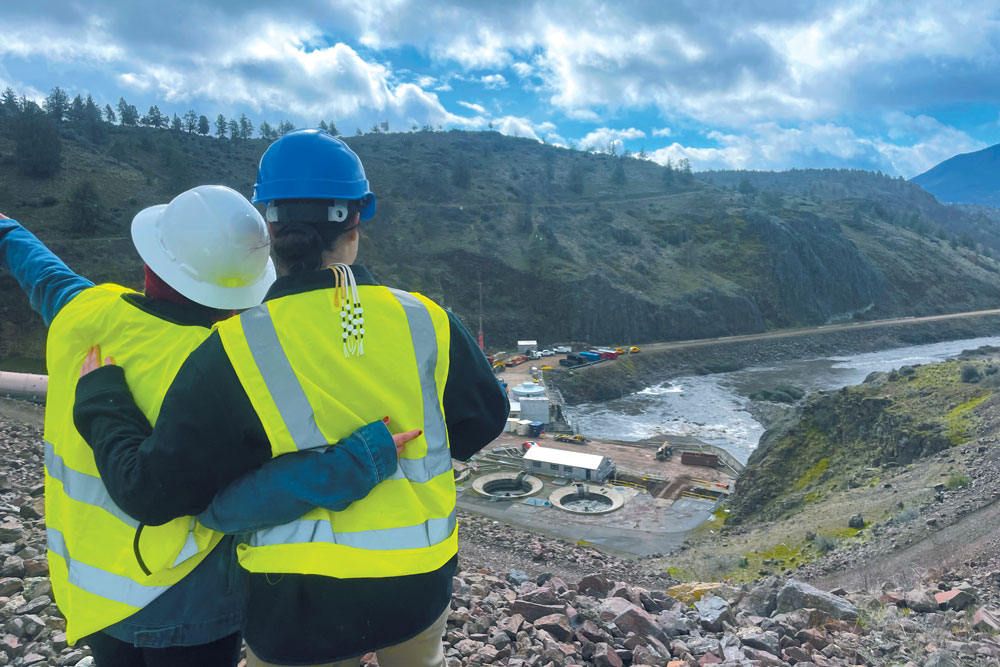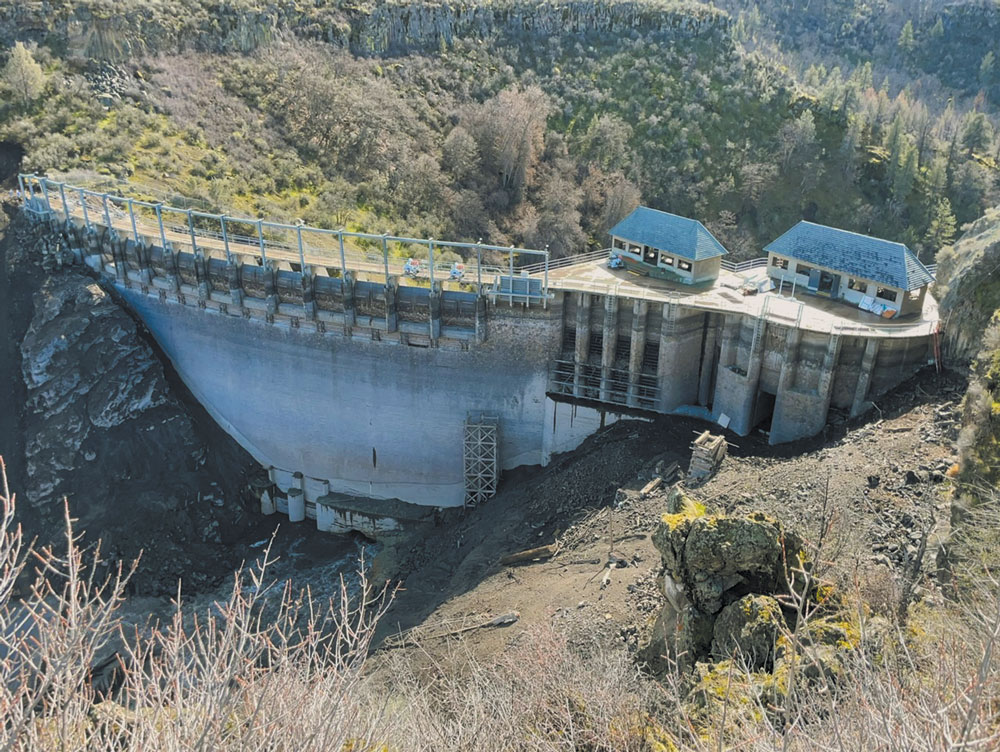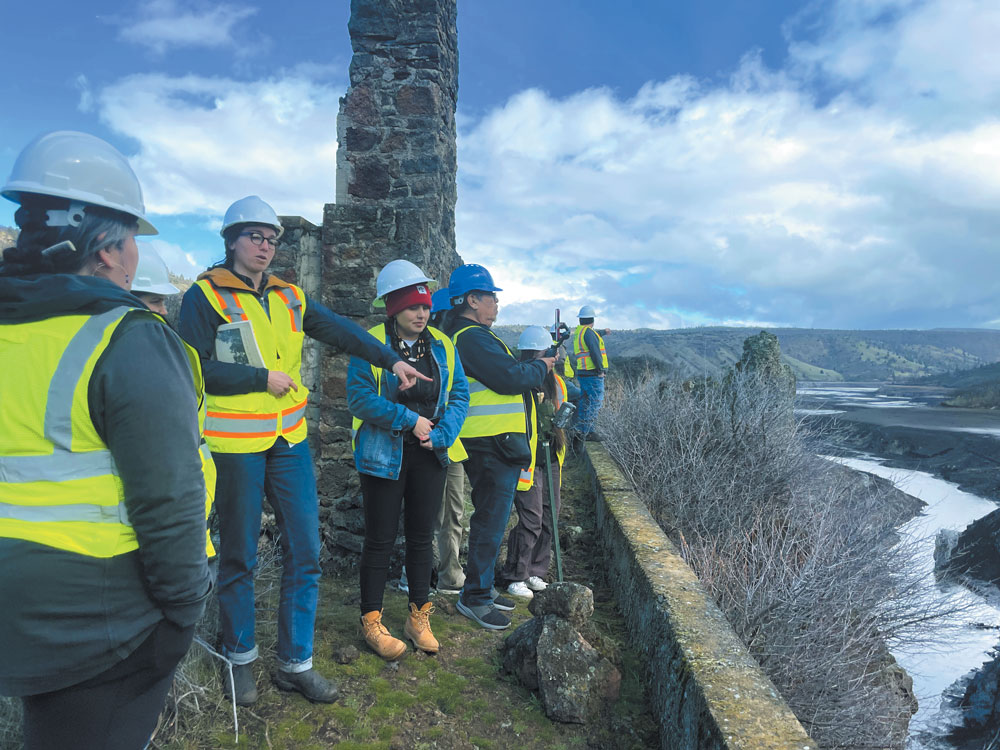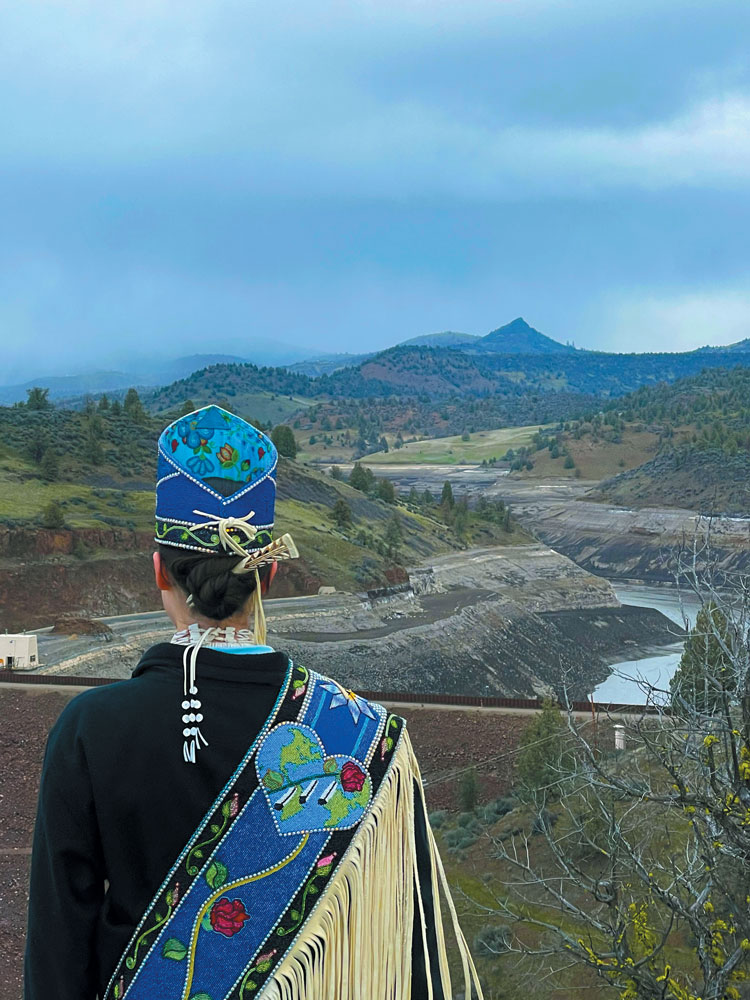About Dam Time!

Downriver Communities Celebrate as Klamath Reservoir Drawdown Begins
By Regina Chichizola, Save California Salmon
A few months after removal of the Copco 2 Dam on the Klamath River in October, 2023, Tribal members and scientists studying the river braved a cold, icy morning on January 11, 2024 to join the Klamath River Renewal Corporation (KRRC) as it initiated the Iron Gate Reservoir drawdown process by opening the low-level outlet tunnel in the Iron Gate Dam for the first time in decades. “Drawdown” refers to the slow, controlled draining of water in a reservoir through tunnels located at the base of the dams. Drawdown of the JC Boyle and Copco reservoirs began last year, and all reservoirs were drained by the end of February. Then, after the rainy season ends, dam removal will begin on the remaining three dams.
Many of the Tribal representatives, government officials, downriver families, and scientists who gathered for this milestone event have worked for Klamath dam removal for more than two decades. The mood was celebratory.
“I am tremendously elated that we are able to honor our relations in such a magnificent way after decades of hard work, sacrifice, and dedication,” said Karuk Tribal member Ron Reed. “We couldn’t ask for anything more. As we move forward we are going to be able to practice our Indigenous identity from this point forward. This is the end of one era, and we are moving into another. The era we are coming from is the era of extraction. We are going to the era of diversity. This is a magnificent moment. I am humbled to be here and honored at the same time.”

Reed, one of the initial organizers for dam removal from the Karuk Tribe, emphasized that holders of Traditional Ecological Knowledge and Western scientists worked together for dam removal. He said these partnerships and the implementation of traditional knowledge are important to the future of science.
Collaboration Is Key
KRRC, which was created for the purpose of Klamath dam removal, invited five Tribes, local residents, and scientists from the California EPA, California Water Board, California Fish and Wildlife, Oregon’s Natural Resource Agencies, and multiple federal agencies to see the dried-out spillway, remnants of the old fish hatchery, and gushing tunnel on this day. Many downriver residents expressed excitement that the flows from the reservoirs looked higher and cleaner than they expected. Others said they were so happy that their children will never again see salmon throwing themselves against the Iron Gate dam.
“I do believe it is a precaution to say it will be really sediment-rich. I think the river is going to clean itself very fast,” Karuk Vice Chairman and fisheries scientist Kenneth Brink said as KRRC addressed questions about short-term water quality impacts from the reservoir releases. “Also, downriver we are used to sediment. We have had catastrophic forest fires that sent sediment down the river. The fish are used to it, we are used to it. I think we will not recognize the Klamath River [after dam removal]. I think it is going to be clean soon.”

Many in the crowd agreed and pointed out that if salmon could survive the sediment releases and channel simplification from the Gold Rush, they could survive a short period of winter sediment releases. KRRC pointed out that the initial drawdown period was carefully selected by KRRC’s Aquatic Resources Working Group, which is composed of Tribes and state and federal agencies. These scientists concluded that January and February are the ideal months for this process, as there are the fewest threatened and endangered species in the mainstem, and winter flows will assist with sediment evacuation. Others noted that in other dam removals, sediment was deposited beside the rivers and estuaries in a way that created new habitats for traditional foods.
The Next Phase
KRRC is taking every precaution to make sure drawdown is done slowly and safely, so downriver communities and species experience minimal impacts.
“Iron Gate’s drawdown strategy is different than what people may have seen in the past with other dam removals,” wrote Mark Bransom from KRRC in a press release. “There was no blast at this dam; instead we had the opportunity to use existing infrastructure, which allows us to precisely control the volume of water going downriver, limiting downstream impacts.”
The environmental regulators and scientists at the scene were elated. “The purpose of us coming out was to simply commemorate the next phase of restoring health to the river,” stated Clayton Creager, a North Coast Water Quality Control Board scientist who worked on dam-removal studies for decades. “It quickly grew via word of mouth to include many more scientists who collectively have worked on dam removal and other restoration objectives throughout the watershed.”
Multiple generations of local families have been part of the movement for dam removal, and some were able to come together as families to witness drawdown. The youngest person present at the event was only one year old and was joined by her grandmother and KRRC board member (appointed by the Karuk Tribe) Wendy Ferris-George: “I began my work on the Klamath River over two decades ago. It’s been a long, grueling fight for the tribal people. Many years ago we formed a grassroots coalition to take on the people who were destroying our way of life. It was the first time in modern history that tribes and traditional practitioners were able to unite on an issue. In the beginning, there was no mercy by farmers, irrigators, or the tribes. We all came to the table ready to fight the biggest fight of our lives. At times, it was extremely challenging. There were moments of tears, fights, sadness, and plenty of milestones worth celebrating. Today is surreal. It is a historic moment in time, and I think our ancestors are proud of the work we all did.”

Members of the Klamath Justice Coalition also joined the tour on that day. They brought one of the banners from the 20-year movement for dam removal to leave at Iron Gate and expressed appreciation for the many organizations that joined the movement for dam removal throughout the years, such as Ruckus Society’s Indigenous People’s Power Project. They voiced the hope that soon they too can celebrate dam removal [in their watersheds.] When asked how she felt about dam removal moving forward, Dania Rose Colgrove said, “It was well worth all of the trips and all of the meetings.”
While the crowds at the dam were in high spirits, they also acknowledged that it has been a long, hard road to get here. “This is a new beginning,” said Leaf Hillman. “I reflect back, and a lot of people who started this journey with us are not here anymore. I am proud for them, there are too many names to name. I am thinking about them and about our future generations.”
For more information: www.californiasalmon.org
